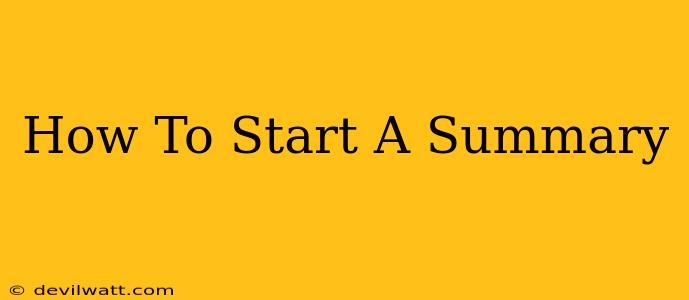Starting a summary effectively is crucial. A strong opening immediately engages the reader and sets the stage for a concise and informative overview. A weak start, on the other hand, can lose your audience before you've even begun to convey the main points. This guide will walk you through several proven techniques for crafting compelling summary introductions.
Understanding Your Audience and Purpose
Before diving into specific techniques, consider these crucial factors:
-
Your Audience: Who are you writing for? Are they familiar with the source material? Adjust your language and level of detail accordingly. A summary for experts requires less background information than one for a general audience.
-
Your Purpose: Why are you writing this summary? Is it for an academic assignment, a professional report, or a personal note? The purpose will shape your tone and approach. A summary for a critical analysis will differ significantly from a summary for a quick overview.
Powerful Techniques for Starting a Summary
Here are several effective ways to begin your summary:
1. The Direct Approach: State the Main Point Upfront
This is often the most efficient method, particularly for concise summaries. Clearly state the central theme or argument of the original text.
Example: "This report summarizes the findings of Dr. Smith's research on the impact of social media on adolescent mental health, concluding that excessive use is correlated with increased anxiety and depression."
2. The Contextual Approach: Set the Stage with Background Information
Provide brief background information to establish context and relevance for your reader. This is helpful if the source material is complex or requires some introductory explanation.
Example: "Against the backdrop of rising concerns about climate change and dwindling natural resources, the Green Energy Initiative's recent report proposes several innovative strategies for sustainable development."
3. The Engaging Question Approach: Hook the Reader's Curiosity
Start with a thought-provoking question that directly relates to the main subject of the original text. This sparks curiosity and encourages the reader to learn more.
Example: "What are the long-term implications of artificial intelligence on the job market? This summary explores the key findings of a recent study analyzing the potential displacement of workers due to automation."
4. The Hook Approach: Start with a Compelling Statement
Begin with a striking statement, statistic, or anecdote that captures the reader's attention and highlights the importance of the summary’s topic.
Example: "Over 70% of participants in the latest consumer survey reported dissatisfaction with current customer service practices. This summary analyzes the key factors contributing to this negative trend."
5. The Thesis Statement Approach (for Academic Summaries)
Similar to the direct approach, but provides a more analytical lens. It presents the main argument and the approach your summary will take to analyze it.
Example: "While the author's arguments regarding the benefits of renewable energy are compelling, this summary will focus on the critique of the economic feasibility of these alternatives, highlighting the substantial financial investment required."
Key Considerations for All Summary Introductions:
- Brevity: Keep your introduction concise and focused. Avoid unnecessary details.
- Clarity: Use clear and precise language.
- Accuracy: Ensure that your introduction accurately reflects the content of the original text.
By mastering these techniques, you can craft impactful summary introductions that engage your readers and effectively set the stage for a clear and informative overview of the original material. Remember to practice and experiment to find the approach that best suits your writing style and the specific requirements of each summary.

